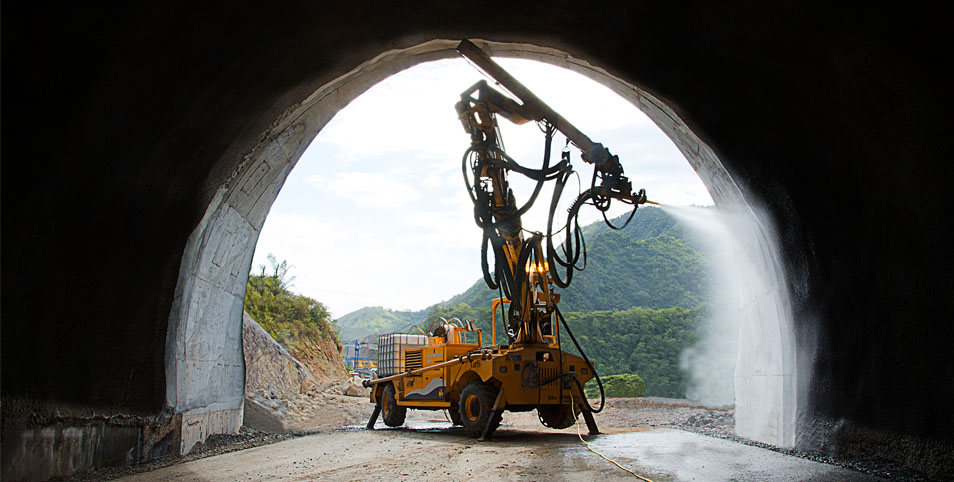In the ever-evolving world of underground construction and mining, innovative technologies continually emerge to enhance safety, efficiency, and cost-effectiveness. One such innovation that has gained significant attention in recent years is the use of Thin Spray-on Liners (TSL) for underground concrete support. This article explores the nature of TSLs, their applications, advantages, and their growing role in underground support systems.
Understanding Thin Spray-on Liners (TSL)
Definition and Composition
Thin Spray-on Liners are polymer-based materials that are applied in thin layers (typically 3-5mm thick) onto rock surfaces in underground environments. They are designed to provide immediate support and sealing to excavated surfaces. The composition of TSLs can vary, but they generally fall into two main categories:
- Polyurethane-based TSLs: Fast-setting, highly adhesive, and flexible
- Polyurea-based TSLs: Extremely fast-setting with high elongation properties
Some TSLs also incorporate cementitious materials or other additives to enhance specific properties.
Key Characteristics
- Rapid application and curing: Most TSLs set within minutes and achieve full strength within hours
- High adhesion: Strong bonding to various rock types and minerals
- Flexibility: Ability to deform without losing adhesion or integrity
- Waterproofing: Excellent water and gas sealing properties
- Thin profile: Minimal reduction in tunnel or drift dimensions
- Non-flammability: Many formulations are designed to be fire-resistant
Applications in Underground Support
Thin Spray-on Liners find applications in various underground concrete support settings:
1. Mining
- Development headings: Rapid support of newly exposed rock faces
- Temporary support: In areas awaiting permanent support installation
- Rehabilitation: Sealing and supporting old workings
- Vent seal: Creating airtight seals in ventilation systems
2. Tunneling
- Initial support: Providing immediate stability post-excavation
- Waterproofing: Creating a water barrier in conjunction with other support systems
- Final lining: In some cases, as part of a composite support system
3. Underground Storage
- Gas containment: Sealing rock surfaces in underground gas storage facilities
- Water reservoirs: Lining underground water storage caverns
4. Civil Engineering
- Slope stabilization: Surface support for open pit mines or road cuts
- Underground parking: Aesthetic and functional lining for rock caverns
Advantages of TSL in Underground Concrete Support
The use of Thin Spray-on Liners offers several advantages over traditional support methods:
- Rapid installation: Significantly faster than conventional shotcrete or mesh installation
- Immediate support: Provides instant surface support upon application
- Reduced excavation: Thin profile allows for smaller excavation dimensions
- Lightweight: Easier transport and handling in underground environments
- Versatility: Can be applied to various surface geometries and conditions
- Reduced rebound: Minimal material waste compared to shotcrete
- Enhanced safety: Rapid application reduces exposure time for workers in unsupported areas
- Corrosion resistance: Many TSLs are not affected by corrosive environments
Comparison with Traditional Support Methods
To understand the role of TSLs in underground support, it’s helpful to compare them with traditional methods:
TSL vs. Shotcrete
| Aspect | TSL | Shotcrete |
| Thickness | 3-5mm | 50-200mm |
| Setting time | Minutes | Hours |
| Strength development | Rapid (hours) | Gradual (days) |
| Flexibility | High | Low |
| Water sealing | Excellent | Good (with additives) |
| Dust generation | Minimal | Significant |
| Rebound | Negligible | 15-30% |
TSL vs. Mesh and Bolts
| Aspect | TSL | Mesh and Bolts |
| Surface coverage | Complete | Partial |
| Installation speed | Very fast | Slow |
| Adaptability to surface | Excellent | Limited |
| Corrosion resistance | High | Variable |
| Maintenance | Low | Higher |
Design Considerations for TSL Support Systems
When incorporating TSLs into underground support designs, several factors must be considered:
- Ground conditions: Rock type, fracturing, and stress state
- Support requirements: Load-bearing needs and expected deformation
- Environmental factors: Presence of water, temperature, and chemical exposure
- Application method: Sprayed or troweled application
- Integration with other support elements: Bolts, mesh, or shotcrete
- Long-term performance: Durability and maintenance requirements
- Ventilation: Ensuring adequate air quality during application
Application Process
The application of TSLs typically involves the following steps:
- Surface preparation: Cleaning and, if necessary, dampening the rock surface
- Material preparation: Mixing components according to manufacturer specifications
- Application: Spraying or troweling the material onto the surface
- Quality control: Checking thickness, coverage, and adhesion
- Curing: Allowing the material to set and gain strength (usually rapid)
Challenges and Limitations
While TSLs offer many advantages, they also have some limitations:
- Load-bearing capacity: Generally lower than thick shotcrete layers
- Long-term durability: Less historical data compared to traditional methods
- Cost: Initial material costs can be higher than conventional supports
- Application conditions: Sensitive to surface moisture and temperature
- Specialized equipment: May require specific spraying or mixing equipment
- Training: Skilled operators needed for proper application
Case Studies
1. South African Gold Mine
A deep-level gold mine implemented TSLs to combat falls of ground in high-stress areas:
- Application: 4mm thick polyurea-based TSL
- Results: 60% reduction in small-scale rock falls, improved worker safety
2. Australian Coal Mine
An underground coal mine used TSLs for rib support and ventilation control:
- Application: Polymer-based TSL in conjunction with bolts
- Results: Enhanced rib stability, reduced ventilation leakage, and improved dust control
3. Alpine Tunnel Project
A road tunnel project utilized TSLs for temporary support and waterproofing:
- Application: Hybrid cementitious-polymer TSL as part of a composite lining system
- Results: Rapid advance rates, excellent water control, and reduced overall lining thickness
Future Trends and Research Directions
The field of Thin Spray-on Liners continues to evolve, with several exciting areas of development:
- Eco-friendly formulations: Developing TSLs with reduced environmental impact
- Nano-enhanced TSLs: Incorporating nanomaterials for improved properties
- Self-healing TSLs: Materials capable of autonomously repairing minor damage
- Smart TSLs: Incorporating sensors for real-time monitoring of ground conditions
- Hybrid systems: Optimizing combinations of TSLs with traditional support methods
- Standardization: Developing industry-wide standards for TSL testing and application
Conclusion
Thin Spray-on Liners represent a significant advancement in underground concrete support technology. Their rapid application, immediate effectiveness, and versatility make them an attractive option for a wide range of underground construction and mining applications. While they may not completely replace traditional support methods in all situations, TSLs offer a valuable addition to the underground engineer’s toolkit.
As research continues and long-term performance data accumulates, the role of TSLs in underground support is likely to expand. Their ability to provide rapid, flexible, and effective support aligns well with the industry’s ongoing push for safer, more efficient, and more sustainable underground operations.
For professionals in tunneling, mining, and underground construction, understanding the capabilities and limitations of TSLs is becoming increasingly important. As these materials continue to evolve and improve, they promise to play an ever-greater role in shaping the future of underground support systems.








